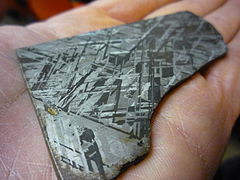Kamacite
| Kamacite | |
|---|---|

Widmanstätten pattern showing the two forms of nickel-iron minerals, kamacite and taenite
|
|
| General | |
| Category | Meteorite mineral |
|
Formula (repeating unit) |
α-(Fe,Ni); Fe0+0.9Ni0.1 |
| Strunz classification | 1.AE.05 |
| Crystal system | Isometric |
| Crystal class | Hexoctahedral (m3m) H-M symbol: (4/m 3 2/m) |
| Space group | Im3m |
| Identification | |
| Formula mass | 56.13 g/mol |
| Color | Iron black, steel gray |
| Crystal habit | Massive – uniformly indistinguishable crystals forming large masses |
| Cleavage | Indistinct |
| Fracture | Hackly – Jagged, torn surfaces, (e.g. fractured metals). |
| Mohs scale hardness | 4 |
| Luster | metallic |
| Streak | gray |
| Specific gravity | 7.9 |
| Other characteristics | non-radioactive, magnetic, non-fluorescent. |
| References | |
Kamacite is an alloy of iron and nickel, which is found on Earth only in meteorites. The proportion iron:nickel is between 90:10 and 95:5; small quantities of other elements, such as cobalt or carbon may also be present. The mineral has a metallic luster, is gray and has no clear cleavage although its crystal structure is isometric-hexoctahedral. Its density is about 8 g/cm3 and its hardness is 4 on the Mohs scale. It is also sometimes called balkeneisen.
The name was coined in 1861 and is derived from the Greek root καμακ- "kamak" or κάμαξ "kamaks", meaning vine-pole. It is a major constituent of iron meteorites (octahedrite and hexahedrite types). In the octahedrites it is found in bands interleaving with taenite forming Widmanstätten patterns. In hexahedrites, fine parallel lines called Neumann lines are often seen, which are evidence for structural deformation of adjacent kamacite plates due to shock from impacts.
At times kamacite can be found so closely intermixed with taenite that it is difficult to distinguish them visually, forming plessite. The largest documented kamacite crystal measured 92×54×23 cm (36.2×21.3×9.1 in).
Kamacite has many unique physical properties including Thomson structures and extremely high density.
Kamacite is opaque, and its surface generally displays varying shades of gray streaking, or "quilting" patterns. Kamacite has a metallic luster. Kamacite can vary in hardness based on the extent of shock it has undergone, but commonly ranks a four on the mohs hardness scale. Shock increases kamacite hardness, but this is not 100% reliable in determining shock histories as there is a myriad of other reasons the hardness of kamacite could increase.
...
Wikipedia
